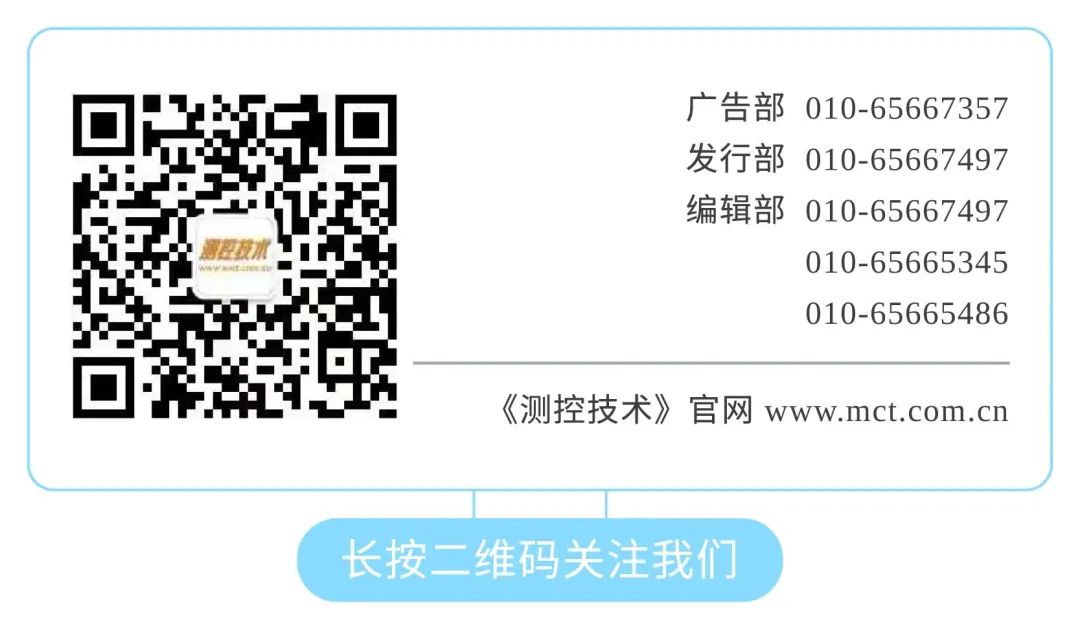“The Internet of Things” is the ultimate ideal of the IoT industry. IoT Analytics reports that the current number of active IoT terminals worldwide is 12.3 billion, and it is expected to exceed 27 billion by 2025. To achieve more terminal interconnections, relying solely on LPWAN technologies such as NB-IoT and LoRa is far from sufficient. Facing issues like complex communication environments, varying terminal forms, and networking communication costs, how to further enhance terminal coverage has become a key point affecting the rapid development of the IoT industry.
With the explosive growth in connection numbers, the power consumption and signal interference issues of IoT terminals have become important directions for technological breakthroughs. Currently, the concept of Passive IoT, derived from RFID technology, is also gaining popularity. Passive IoT refers to IoT terminal network nodes that do not require an external “energy source” but instead utilize environmental energy harvesting for power supply. This technology is regarded as key to achieving the vision of “hundreds of billions of connections”.
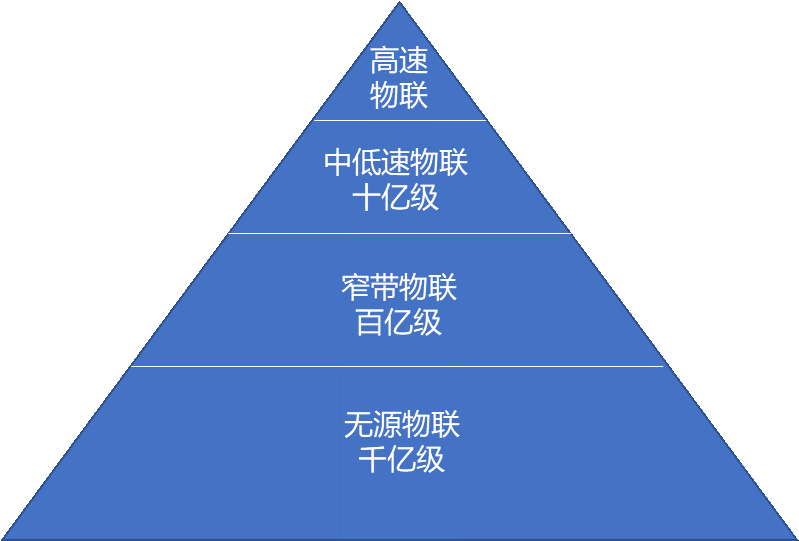
Distribution Model of IoT Connections
Zero-Power Passive IoT
Facilitating the Interconnection of Hundreds of Billions of Terminals
Passive IoT was initially applied in the military field and gradually penetrated into industrial and transportation sectors. With the emergence of new digital tagging technologies, Passive IoT has further expanded from RFID to include Wi-Fi, Bluetooth, UWB, LoRa, 5G, and other cellular/non-cellular technologies. The biggest advantage of Passive IoT is that it can connect and communicate without battery power, making it a hopeful solution for meeting energy supply needs across a wider range.
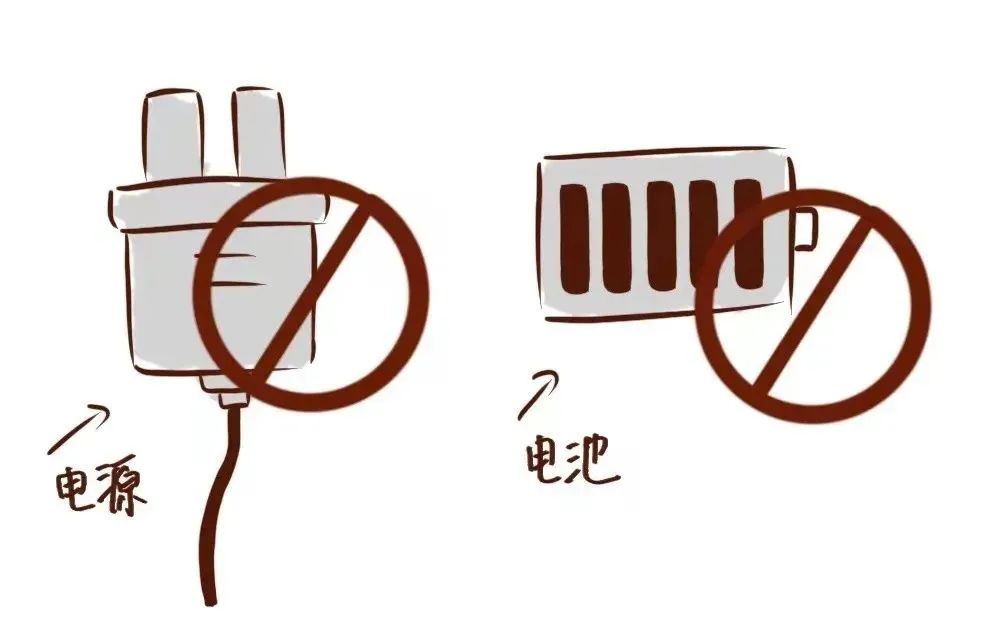
The research on Passive IoT mainly relies on three underlying technologies:
First, environmental energy harvesting. Passive IoT tags do not depend on batteries or power lines; instead, they capture energy from the environment and convert it into usable electrical energy. The energy sources can include light, heat, kinetic energy, and radio frequency. Solar energy is currently the most efficient conversion solution, with energy conversion efficiency reaching up to 50% under a single frequency band, only 1-2% in complex multi-frequency scenarios, and temperature difference energy harvesting has environmental requirements with conversion efficiency below 10%. Below are the pros and cons of several mature energy harvesting technologies:
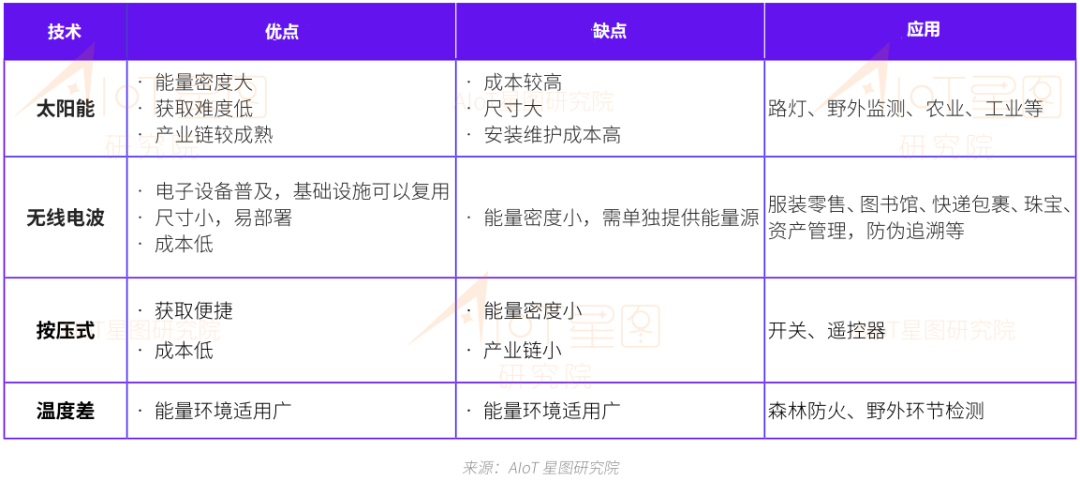
Second, low-power computing. The energy available for Passive IoT terminals during operation is limited, which determines that the power consumption requirements for driving circuits or chips for computing cannot be too high. Currently, mature low-power computing MCU chips generally operate at the μW level.
Finally, relying on low-power communication—”backscatter” to achieve data communication. Passive IoT terminals mainly use low-energy, short-range, low-speed communication technologies, relying more on backscatter to reflect received radio frequency signals for data transmission.
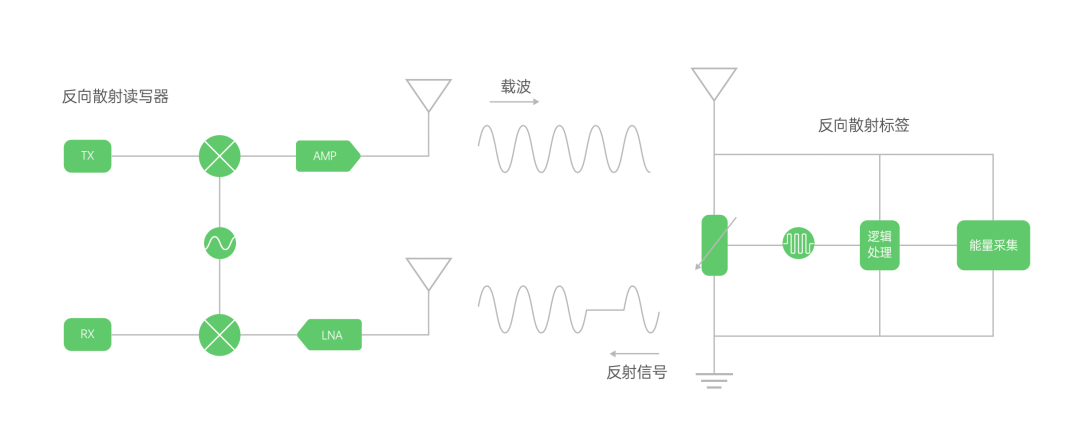
Backscatter Communication Principle Diagram Source: OPPO “Zero-Power Communication” Report
Currently, we are at a critical period of innovation in passive technology. The IoT Research Institute of China Mobile believes that the evolution path of passive IoT technology can be divided into Passive 1.0, Networked Passive 2.0, and Cellular Passive 3.0 stages. Traditional RFID applications adopt a point-to-point short-range read-write architecture, which has strong self-interference and mutual interference issues, primarily applied in fast-moving consumer goods and warehousing sectors. New networked Passive 2.0 technology adopts a separate receiving and transmitting system, supporting network deployment, solving interference issues, and improving reception distance, thus expanding the application scenarios of RFID to some extent.
In the 3.0 stage, the advantages of cellular networks can be further leveraged to extend communication distances using base stations, providing possibilities for networked application needs in larger and more complex scenarios, such as asset lifecycle management. For example, in 2021, Huawei proposed the concept of 5.5G Passive IoT Passive IoT, which extends the transmission distance of RFID-supported scenarios from 10 meters to hundreds of meters through cellular networks, eliminating the need for dedicated readers and allowing terminals to self-report back to cellular gateway nodes.

With advantages like zero power and small size, Passive IoT has a wide range of application prospects in industrial sensors, smart transportation, smart logistics, smart warehousing, smart agriculture, smart cities, and energy sectors in industrial IoT, as well as in consumer IoT fields like smart wearables, smart homes, and healthcare.
For example, in the industrial sensor field, achieving industrial automation, environmental sensing, and safety monitoring requires deploying a large number of sensor nodes in complex and hazardous environments. Low cost, low power consumption, and small size are the basic requirements for communication devices in this field. Passive IoT can extend the lifecycle of sensor nodes and reduce maintenance costs through energy harvesting and backscatter technologies.
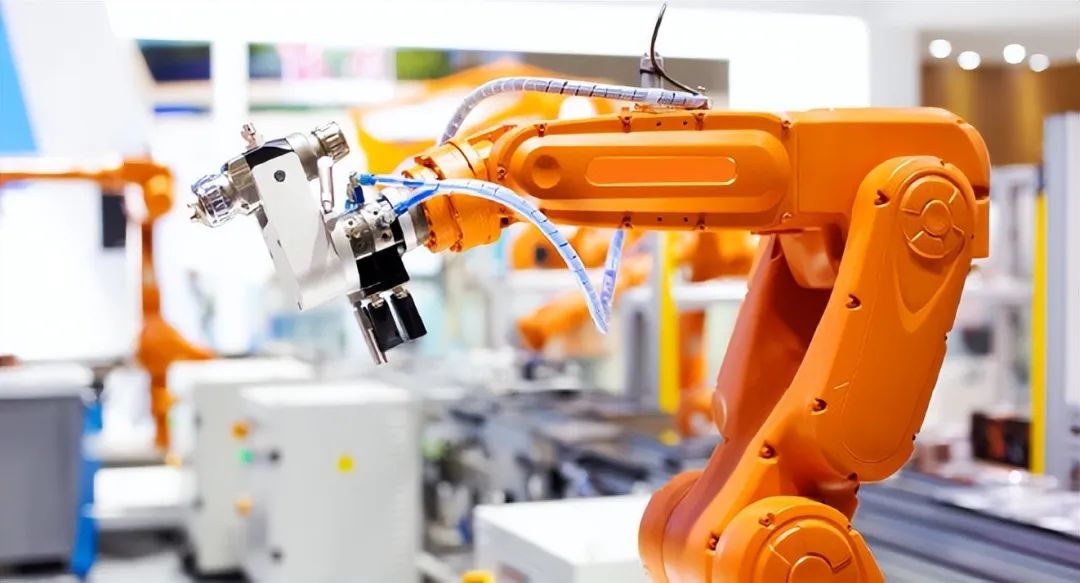
Image Source: Espressif Technology
Similarly, in the logistics and retail industry, to intelligently manage a vast number of inexpensive items, it is necessary to endow items with networking capabilities. Currently, the cost of retail tags has dropped to around 0.3 yuan, and logistics tags are expected to reduce to about 0.1 yuan. Using Passive IoT technology in frequently operating scenarios can save a significant amount of hardware, power supply, and labor management costs, significantly improving logistics and warehousing management efficiency.
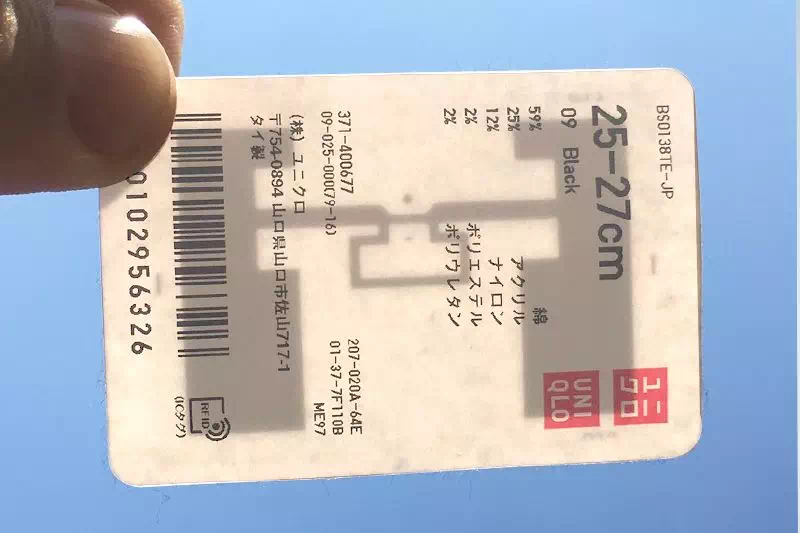
RFID tags installed in clothing hangtags Image Source: Uniqlo
Various Passive IoT Technologies:
RFID Dominates the Market, Related Technologies Are Emerging
In terms of technological maturity, Passive IoT technologies can be divided into mature applications represented by RFID and NFC, and theoretical research routes powered by energy harvesting from Wi-Fi, Bluetooth, 5G, LoRa, etc.
RFID-Based Passive IoT:
RFID technology is the most familiar and widely used passive IoT technology. Its principle is very simple. When an RFID tag approaches a reader, it receives the radio frequency signals emitted by the reader, generating induced current to obtain energy. Using the collected energy, the tag sends information via an internal antenna, achieving communication with the reader.
As the core underlying technology of Passive IoT, RFID technology is applied in hundreds of industries that require identification and management, including warehousing logistics, smart retail, intelligent manufacturing, clothing management, smart healthcare, and air transportation. These numerous physical terminals can become coverage nodes in the hundreds of billions of IoT. According to statistics from the AIoT Star Map Research Institute, in 2021, the global shipment of UHF RFID alone reached about 23 billion, and when combined with low-frequency and high-frequency, the total shipment of passive RFID worldwide approached 30 billion that year.
With cost advantages, RFID is currently the optimal solution for the hundreds of billions of passive IoT technology, but it also has limitations such as small data storage capacity and poorer interactivity with Bluetooth, NFC, and 5G technologies compared to mobile phones. Different scenarios require combining other passive IoT technologies to meet application spaces.
On May 10, the AIoT Star Map Research Institute surveyed over 100 representative enterprises and industry experts across various frequency bands and industrial chains of passive IoT, completing“China RFID Passive IoT Market Research Report (2022 Edition)”, scan the QR code below to immediately obtain the report.
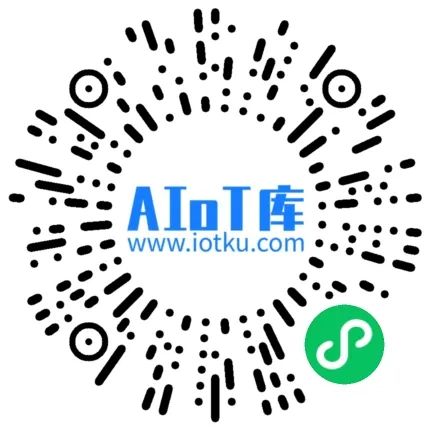
NFC-Based Passive IoT:
NFC (Near Field Communication) is a short-range high-frequency wireless communication technology, a variant of high-frequency RFID technology, enabling non-contact data exchange within 10cm. Unlike RFID, NFC is a highly integrated single-chip, relatively expensive, primarily used in high-security information transmission scenarios, commonly in transportation, access control, mobile payments, and other functions.
Bluetooth-Based Passive IoT:
BLE (Bluetooth Low Energy) is familiar to us. Passive Bluetooth low-energy sensor tags that can sense, store, and communicate without power have successfully hit the market. These tags harvest surrounding wireless RF energy to power themselves and use this energy to send unique identification codes and sensor readings.

This is a product from the Israeli company Wiliot called Wiliot IoT Pixels, which powers itself by capturing weak signals from 4G/5G, Wi-Fi, Zigbee, LoRa, etc., and sends data back to the cloud platform. This tag requires no additional battery, is only the size of a postage stamp, and can be conveniently attached to various items. It is currently used in vaccine vials, food packaging, and other consumer production and retail scenarios.
Wi-Fi-Based Passive IoT:
Researchers at the University of Washington developed a Passive Wi-Fi technology in 2016, where passive nodes consume only 14.5µW and 59.2µW to transmit at 1Mbps and 11Mbps, respectively, achieving a return distance of 30 meters and even having some wall-penetrating capability.
This design principle is similar to that of RFID chips, using backscatter communication technology of radio frequency signals. When nearby Wi-Fi routers emit relatively high-powered radio frequency signals, passive IoT nodes absorb these signals and modulate the antenna’s reflection coefficient to transmit sensor information.
5G/6G Cellular-Based Passive IoT:
Wang Tao, President of Huawei ICT, believes that many IoT applications currently rely on passive connections, and enhancing the recognition rate, coverage, and positioning accuracy of passive IoT through networked technologies is the direction of future evolution and innovation for 5G networks. Cellular signals are one of the most widely available wireless radio frequency signals in the environment. The core difficulties in achieving passive connections are twofold: first, how to harvest energy, and second, how to achieve long-distance backhaul, especially the latter being more challenging to maintain efficient communication. The energy harvested by passive terminals through various methods is very weak, and if the backhaul path is too long, the signal will quickly attenuate.
Currently, the most advanced technology in laboratory stages can collect about 6µW of power from specific frequency bands of 5G radio frequency within a range of 180 meters.
LoRa and NB-IoT Based Passive IoT:
LoRa, NB-IoT, and other LPWAN terminals inherently prioritize low power consumption as a core technology, and passivization is an upgraded direction of power consumption research.
In 2021, Japan’s Murata Company collaborated with Nowi to launch a battery-free LoRa solution reference platform, using Murata’s LoRa module combined with Nowi’s energy harvesting power management (PMIC) chip for energy supply. Most of these passive solutions are custom collaborations between module manufacturers and energy chip companies, producing compatible LoRa/NB-IoT module products that use linear spread spectrum technology to enhance backhaul capabilities and achieve permanent energy supply through reflection modulation systems.
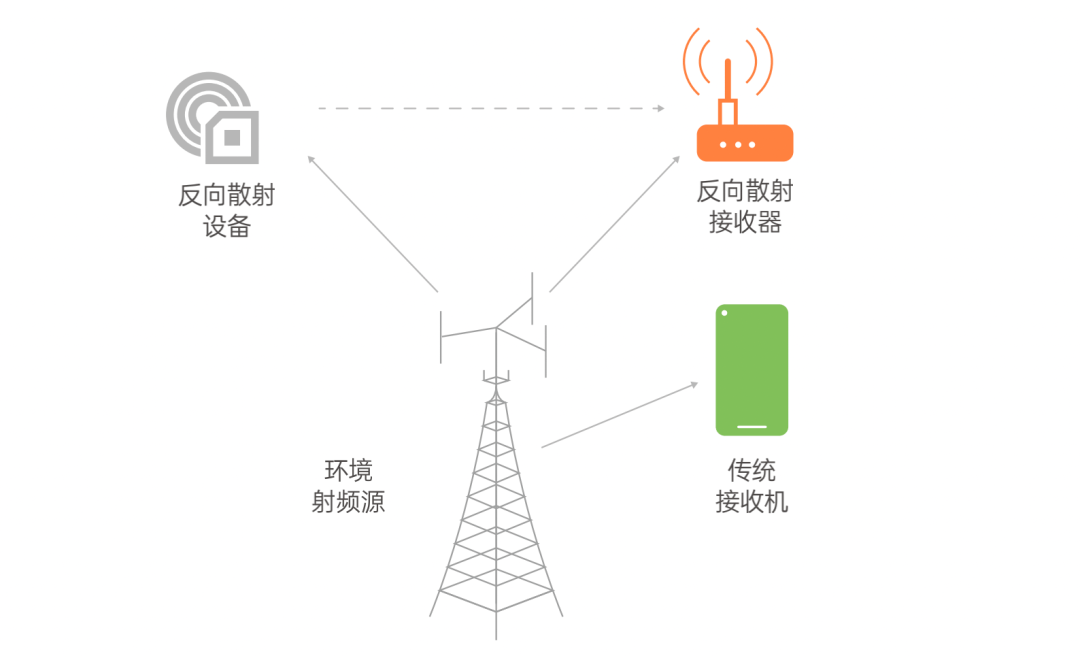
Environmental Backscatter Communication System Source: OPPO “Zero-Power Communication” Report
Many of these new passive technologies are still in the research phase in laboratories, while some, like Bluetooth solutions, have already begun commercial deployment. Once large-scale commercial applications are realized, Passive IoT can not only optimize resource allocation and improve efficiency but also have a disruptive impact on the organizational and industrial forms of industrial environments under the ongoing influence of the pandemic on the “remote economy”.
In the evolution of IoT technology, zero-power communication and passivization are key and long-term goals. Although currently constrained by factors such as the development of communication technology, commercial costs, and customization of application scenarios, commercial solutions beyond RFID are still immature. However, both domestically and internationally, a number of innovative enterprises based on photovoltaic, Bluetooth, Wi-Fi, LoRa, NB-IoT, and 5G have emerged, gradually establishing ecosystems that incorporate low-power passive connection networks in more applications. The following are several visions for the development of Passive IoT technology:
1. More diverse functions for passive tags. Currently, passive tags have single functions, and there is an urgent need to develop multi-functional passive tags that integrate identification, sensing, positioning, and communication to facilitate widespread application in manufacturing, warehousing logistics, healthcare, and other industries in the future.
2. More mature “cost-saving” technologies. Backscatter technology is currently in the early stages of commercialization, and aspects like communication distance, throughput, and security are not yet perfected, limiting applicable scenarios. In the future, to achieve more mature and large-scale commercial applications of Passive IoT, improvements in energy utilization, system communication efficiency, and security mechanisms must be made in these three directions.
3. Unified general protocol standards. As a new communication technology, Passive IoT is expected to deeply integrate with the next-generation communication network technology standards and 6G, becoming a more intelligent and efficient communication standard.
This article is sourced from IoT Media
END
Hot Articles (Swipe up to read)
Recommended Article | Wang Jiulong: Research on Helicopter Tail Rotor Blade Fatigue Testing Technology
Recommended Article | Sun Weihong: Research on Portable ECG Monitoring System Based on Flexible Electrodes
Recommended Article | Zhang Meiju: Research Status and Development Trends of Ceramic Substrate Thin Film Thermocouples
Recommended Article | Ouyang Lin: Fatigue Driving Detection Algorithm Based on Driver Facial Temporal Data
Recommended Article | Zhang Wenli: Multi-Target Tracking Algorithm Based on Improved Transformer and Anchor-free Network
Recommended Article | Liu Guanjun: Research Progress of Silicon-Based and Graphene-Based Resonant Pressure Sensors
Recommended Article | Jiang Chao: Overview of Image-Based UAV Battlefield Situation Awareness Technology
Recommended Article | Zhang Feiyang: Overview of Alertness Detection Research Based on Physiological Signals
Recommended Article | Qiu Fang: Research on Autonomous Management Software Architecture for Spacecraft Control Systems
Recommended Article | Wang Yanshan: Research Progress of Graphene Flexible Pressure/Strain Sensors
Recommended Article | Wang Hong: Research on Testing Technology System Architecture for Civil Aircraft
Recommended Article | Liu Yawei: Overview of Digital Twin and Application Research for Aircraft Structural Health Management
Recommended Article | Sun Zhiyan: Overview of Development of Aircraft Engine Control Systems
Forum | Academician Gao Jinj: Intelligent Monitoring of Vibration Failures in Aircraft Engines
Forum | Wang Haifeng: Understanding and Discussion on Intelligent Development of Aerospace Equipment Support
Forum | Wang Huamao: Overview of Comprehensive Testing Technology and Development Trends for Spacecraft
Forum | Li Kaisheng: Discussion on Testing and Control Technology Needs for Large Aircraft Electrical Systems
2021 Collection of Excellent Papers in Computer and Automation Technology
2020 Collection of Excellent Papers in Aerospace Technology
Journal Dynamics (Swipe up to read)
Notice of Call for Papers for the 2022 Annual Conference of the China Aviation Industry Technology Equipment Engineering Association
Notice of Call for Papers for the 19th China Aviation Measurement and Control Technology Annual Conference
Notice of Call for Papers for the “Equipment Non-Destructive Testing and Health Monitoring” Column of Measurement and Control Technology
Notice of Call for Papers for the “Force Tactile Technology” Column of Measurement and Control Technology
“Measurement and Control Technology” continues to be selected as a “Core Journal of Chinese Science and Technology”
The official website of “Measurement and Control Technology” has been upgraded
Thanks to the review experts of “Measurement and Control Technology” in 2021
Journal Directory (Swipe up to read)
2022 Issue 4
2022 Issue 3
2022 Issue 2
2022 Issue 1
2021 Issue 12
2021 Issue 11 Status Monitoring Sensor Technology Special Issue
2021 Issue 10
2021 Issue 9
2021 Issue 8
2021 Issue 7
2021 Issue 6
2021 Issue 5
2021 Issue 4
2021 Issue 3
2021 Issue 2
2021 Issue 1
2020 Issue 8 Machine Vision Technology Special Issue
2020 Issue 12 Artificial Intelligence and Testing Support Special Issue

